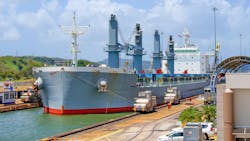Trump, China and Shale: What's Next for the Panama Canal?
Part II of a two-part series: Read Part I: China Saw Opportunity as US Interest Dwindled
All of the Panama Canal expansion activity in the early 2000s almost fell flat on its face. It was built on the expectation of ever-increasing container imports coming from China into the U.S. on even-bigger ships: many of them transiting the new locks of the Canal. That traffic never materialized.
Container traffic through the Canal has remained flat for years. Yet, something more substantial and unforeseen emerged: the American shale energy revolution, bringing with it the need to transport liquified natural gas from the U.S. to all over the world. No one saw this opportunity coming, but with the Canal imporvements, the Panamanians put themselves squarely in a position to benefit. If luck is when opportunity meets preparation, then we’ll call the Panamanians lucky.
More Panama Canal and supply chain news from Endeavor Business Media:
Navigating Supply Chain Disruptions: Then And Now
Michigan Governor Says Trump Tariffs on Mexico, Canada Could Harm US Auto Sector
Leveraging data to optimize shipping through the Panama Canal while protecting local water supply
In 2016, the first liquefied natural gas (LNG) carrier made its journey through the Canal. Thanks to the expansion, the Canal could accommodate 90% of the world’s LNG tankers—majorly impacting global LNG flows.
The Canal offers significant reductions in voyage times for vessels departing the U.S East and Gulf Coasts for Asia, making U.S. gas deliveries to major Asian importers such as China, India, Japan and Korea more competitive. Vessels departing the U.S. Gulf Coast for the West Coast of South America similarly experience generous time savings. LNG ships from production plants in Trinidad and Tobago through Chile for re-gasification, saving six days in transit time compared to the historic route through the Magellan Straits around Cape Horn.
Trump, China, and the Canal Today
When the Canal treaties were negotiated nearly 40 years ago, no one could have foreseen China's global rise nor the American shale energy revolution. Yet, today, both are shaping the current and future global power structure, and that of the Canal. As President Trump previously sought to renegotiate other deals which had their origins many decades previous (NAFTA, NATO, etc.) the original deal on the Canal with Panama seems inevitable for a revisit.
If this is the case, what will it mean for the users of the Canal? To that question: likely not much at all. The Canal’s increasing importance to all parties makes it very hard for anyone, even a U.S. President, to alter the day-to-day operations of the Canal. Behind the scenes, however, things could change significantly.
It would be hard to imagine a scenario where the U.S. mobilizes military force to enforce the Canal’s neutrality. First of all, the definition of neutrality is a legal one and subject to interpretation. Does Panama’s ongoing integration of international partners to improve and operate the Canal—most critically China—violate the spirit of neutrality? That would be a tough argument to prove.
On the other hand, might the U.S. use a carrot-and-stick on Panama to have it reconsider the relationships with China and move closer to the U.S? This is more likely.
As the biggest user of the Canal, the U.S. could cajole Panama to “reconsider “some of its current partners in the future and replace them with partners more favorable to the U.S.
A more feasible option might be to provide government incentives to U.S. firms when bids at the Canal open up. Such an approach is not an outlier. The U.S. government has historically provided generous subsidies to American firms who do business in places vital to national security. For example, the Export-Import Bank of the United States (EXIM Bank) has the Transportation Security Exports Program (T-SEP). This initiative provides enhanced financing support to programs that bolster the security of systems that support the movement of passengers and cargo between countries.
Another issue at the top of the Panama / U.S. agenda is illegal immigration. As President Trump quickly moves to secure the U.S. border, he will also be looking reduce the migrant inflows into Mexico reduce pressure there. Since 2021, an estimated 1.5 to 2 million migrants (including several hundred thousand Chinese nationals) have walked through the extremely dangerous Darien Gap from Colombia into Panama, and then headed north towards the U.S.
The new President of Panama, Raul Mulino, has promised to secure his eastern border. While foot traffic appears to be slowing, gaps remain. A negotiated deal between the two nations on the future of the Canal will surely include illegal immigration.
Finally, it would be wise to pay attention to what candidate Trump said on the campaign trail over the past year. His closing remarks at the rallies that defined his campaign almost always included “digging out the Panama Canal” as a shining example of what had made America great.
Coming from Trump the developer and builder, this should be no surprise. In the end, it seems President Trump’s personal affinity for the Panama Canal, along with the issues of rising Chinese influence and immigration reform, will keep the Canal near the front page for years to come.
About the Author
Andrew R. Thomas
Bestselling business author & associate professor of marketing and international business
Andrew R. Thomas' most recent book is The Canal of Panama and Globalization: Growth and Challenges in the 21st Century (2022). He is an associate professor of marketing and international business at the University of Akron.
A successful global entrepreneur, Dr. Thomas was a principal in the first firm to ever export motor vehicles from China. He has traveled to and conducted business in 120 countries on all seven continents.
